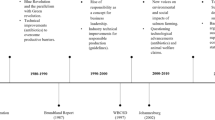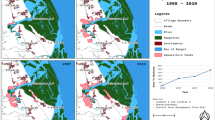Abstract
This paper assesses the significance of stakeholder discourses on uses of water by aquaculture for public policy. Our discourse analysis focuses on the experiences with inland aquaculture in Thailand, drawing from interviews with stakeholders, and evidence in public documents such as newspapers and television news reports. A key finding is that fish farms suffer significant losses from polluted run-off entering water bodies where fish are grown. Mass mortality events in river cage culture, in particular, attract media attention and are the core of the aquaculture-as-victim discourse. Fish farms are also adversely impacted by river management and current water allocation policies. Inland shrimp farming has received more negative media and scientific attention than fish farming, and is the focus of the aquaculture-as-villain discourse. A third, aquaculture-as-benign discourse, is used widely to describe fish pond culture, and more rarely to promote aquaculture in low-quality water bodies or as part of integrated nutrient and waste re-use farming systems. The findings strongly imply that aquaculture farmers should be included as a stakeholder in the management of watersheds and rivers, as well as the negotiation and allocation of water resources. They also suggest a need for aquaculture development policies to pay closer attention to water quality and allocation issues.


Similar content being viewed by others
References
Abate TG, Nielsen R, Nielsen M (2016) Stringency of environmental regulation and aquaculture growth: a cross-country analysis. Aquac Econ Manag 20:201–221. https://doi.org/10.1080/13657305.2016.1156191
ASTV Manager (2014) Fish cage farmers in Nakhon-sri-tammarat faced with mass mortalities of fish costing millions of baht. ASTV Manager, Bangkok, 24 October 2014
Bangkok Post (1995) Shrimp farms to be listed as source of pollution. Bangkok Post, 10 February 1995
Bangkok Post (1998a) Agro-industry: discord over shrimp farming in fields—top fishery officials against proposed ban. Bangkok Post, Bangkok, 7 May 1998
Bangkok Post (1998b) Aquaculture—inland prawn farms seen as threat. Bangkok Post, Bangkok, 10 December 1998
Bangkok Post (2011) Shrimpers hope to net reprieve with new definition. Bangkok Post, Bangkok, 2 October 2011
Bangkok Post (2014) Righting the waterway wrongs. Bangkok Post, Bangkok, 16 February 2014
Bangkok Post (2017) Fish farmers protest pig farm fouling waterways. Bangkok Post, Bangkok, 20 June 2017
Barton JR, Fløysand A (2010) The political ecology of Chilean salmon aquaculture, 1982–2010: a trajectory from economic development to global sustainability. Glob Environ Change 20:739–752. https://doi.org/10.1016/j.gloenvcha.2010.04.001
Belton B, Little DC (2011) Immanent and interventionist inland Asian aquaculture development and its outcomes. Dev Policy Rev 29:459–484. https://doi.org/10.1111/j.1467-7679.2011.00542.x
Bene C (2005) The good, the bad and the ugly: discourse, policy controversies and the role of science in the politics of shrimp farming development. Dev Policy Rev 23:585–614
Boontanon SK, Kunacheva C, Boontanon N, Musirat N, Fujii S, Tanaka S (2013) Occurrence of perfluorooctane sulfonate in the water environment of Bangkok, Thailand. J Environ Eng 139:588–593. https://doi.org/10.1061/(ASCE)EE.1943-7870.0000603
Braaten R, Flaherty M (2001) Salt balances of inland shrimp ponds in Thailand: implications for land and water salinization. Environ Conserv 28:357–367
Bunting SW, Edwards P (2018) Global prospects for safe wastewater reuse through aquaculture. In: Jana BB, Mandal RN, Jayasankar P (eds) Wastewater management through aquaculture. Springer Singapore, Singapore, p 55–72. https://doi.org/10.1007/978-981-10-7248-2_3
Chuenpagdee R, Kooiman J, Pullin R (2008) Assessing governability in capture fisheries, aquaculture and coastal zones. J Transdiscipl Environ Stud 7:1–20
DOF (2015) Fisheries Act B.E. 2558 (2015). Department of Fisheries, Bangkok
Flaherty M, Szuster B, Miller P (2000) Low salinity inland shrimp farming in Thailand. Ambio 29:174–179
GooSiam (2015) Fish deaths from drought in Surin—irrigation department does not release water [in Thai]. GooSiam News, Bangkok, 7 May 2015
Hajer M, Versteeg W (2005) A decade of discourse analysis of environmental politics: achievements, challenges, perspectives. J Environ Policy Plan 7:175–184
Janchitfah S (2011) Floundering under debt. Bangkok Post, Bangkok, 24 April 2011
Kardsakun P, Chaibu P, Chitmanat C, Mangumphan K (2014) Appropriate density of recirculating system Nile tilapia culture in aquaponic [in Thai]. J Fish Technol Res 8:23–32
Kengkaj W (2015) Fish farmers’ utilization of social networks in adapting to drought and water pollution in Upper Northern Thailand. AQUADAPT Working Paper 32. Unit for Social and Environmental Research, Faculty of Social Sciences, Chiang Mai University, Chiang Mai
Khaosod (2007) Four factories inspected after fish deaths in Chao Phraya River [in Thai]. Khao Sod, Bangkok, 13 March 2007
Kupkanchanakul W, Kwonpongsagoon S, Bader HP, Scheidegger R (2015) Integrating spatial land use analysis and mathematical material flow analysis for nutrient management: a case study of the Bang Pakong River Basin in Thailand. Environ Manag 55:1022–1035. https://doi.org/10.1007/s00267-014-0441-5
Lebel L, Lebel P, Chuah CJ (2018) Governance of aquaculture water use. International J Water Resour Dev 1–23 https://doi.org/10.1080/07900627.2018.1457513
Lebel L, Lebel P, Garden P, Giap DH, Khrutmuang S, Nakayama S (2008) Places, chains and plates: governing transitions in the shrimp aquaculture production-consumption system. Globalizations 5:211–226
Lebel L, Lebel P, Lebel B (2016) Impacts, perception and management of climate-related risks to cage aquaculture in the reservoirs of northern Thailand. Environ Manag 58:931–945. https://doi.org/10.1007/s00267-016-0764-5
Lebel P, Whangchai N, Chitmanat C, Promya J, Chaibu P, Sriyasak P, Lebel L (2013) River-based cage aquaculture of Tilapia in northern Thailand: sustainability of rearing and business practices. Nat Resour 4:410–421. https://doi.org/10.4236/nr.2013.45051
Lebel P, Whangchai N, Chitmanat C, Lebel L (2015a) Climate risk management in river-based Tilapia cage culture in northern Thailand. Int J Clim Change Strateg Manag 7:476–498
Lebel P, Whangchai N, Chitmanat C, Lebel L (2015b) Risk of impacts from extreme weather and climate in river-based Tilapia cage culture in Northern Thailand. Int J Glob Warm 8:534–554
Lebel P, Whangchai N, Chitmanat C, Promya J, Lebel L (2015c) Perceptions of climate-related risks and awareness of climate change of fish cage farmers in northern Thailand. Risk Manag 17:1–22. https://doi.org/10.1057/rm.2015.4
Mazur NA, Curtis AL (2006) Risk perceptions, aquaculture, and issues of trust: lessons from Australia. Soc Nat Resour 19:791–808. https://doi.org/10.1080/08941920600835551
McGinnis MV, Collins M (2013) A race for marine space: science, values, and aquaculture planning in New Zealand. Coast Manag 41:401–419. https://doi.org/10.1080/08920753.2013.822284
NBT KhonKaen (2016) Fish farmers push for irrigation department to take responsibility for fish deaths in cages [in Thai]. NBT Khon Kaen Television Station, Khon Kaen, 17 August 2016
Osmundsen TC, Olsen MS (2017) The imperishable controversy over aquaculture. Mar Policy 76:136–142. https://doi.org/10.1016/j.marpol.2016.11.022
Pant J, Demaine H, Edwards P (2004) Assessment of the aquaculture subsystem in integrated agriculture–aquaculture systems in northeast Thailand. Aquac Res 35:289–298
Panuwet P, Siriwong W, Prapamontol T, Ryan PB, Fiedler N, Robson MG, Barr DB (2012) Agricultural pesticide management in Thailand: status and population health risk. Environ Sci Policy 17:72–81
Phitsanulokhotnews (2013) Flooding! More than 10 fish farmers are out of business [in Thai]. Phitisanulok
Pigeon LE, Létourneau L (2014) The leading Canadian NGOs’ discourse on fish farming: from ecocentric intuitions to biocentric solutions. J Agric Environ Ethics 27:767–785. https://doi.org/10.1007/s10806-014-9489-8
Pimolrat P, Whangchai N, Chitmanat C, Promya J, Lebel L (2013) Survey of climate-related risks to Tilapia pond farms in northern Thailand. Int J Geosci 4:54–59
RYT9 (2015) Polluted water from Saraburi reaches Ayutthaya fish farms [in Thai]. RYT9 Channel, Bangkok, 3 April 2015
Sanook (2012) Irrigation diversions affect villagers fish farms killing 3 hundred thousand red tilapia [in Thai]. Sanook, Bangkok, 3 March 2012
Schwantes VS, Diana JS, Yi Y (2009) Social, economic, and production characteristics of giant river prawn Macrobrachium rosenbergii culture in Thailand. Aquaculture 287:120–127
Simachaya W (2009) Wastewater tariffs in Thailand. Ocean Coast Manag 52:378–382. https://doi.org/10.1016/j.ocecoaman.2009.04.012
Soontornprasit K, Meksumpun C (2008) Analysis of aquatic ecosystem response for zone management of Ban Pho Town, Chachoengsao Province, Thailand. Kasetsart J – Nat Sci 42:513–521
Szuster BW, Flaherty M (2002) Cumulative environmental effects of low salinity shrimp farming in Thailand. Impact Assess Proj Apprais 20:189–200. https://doi.org/10.3152/147154602781766672
Tanavud C, Yongchalermchai C, Bennui A, Densrisereekul O (2001) The expansion of inland shrimp farming and its environmental impacts in Songkhla Lake Basin. Kasesart J – Nat Sci 35:326–343
ThaiPBS (2013a) Maejo fisheries tests water quality in the Ping River after death of more than 1 million red tilapia [in Thai]. Thai Public Broadcasting Service News, Bangkok, 7 June 2013
ThaiPBS (2013b) Saraburi Governor accelerates completion of sewage treatment plant after illegal releases of waste water into the Pasak River cause many fish deaths [in Thai]. Thai Public Broadcasting Service News, Bangkok, 17 January 2013
Thai Rath (2016a) Factory release of polluted water kills 17 tonnes of fish [in Thai]. Thai Rath Online, Bangkok, 30 November 2016
Thai Rath (2016b) More than 10 million fish in cages dead [in Thai]. Thai Rath, Bangkok, 19 August 2016
The Nation (1998) Inland shrimp farms to be controlled. The Nation, Bangkok, 12 April 1998
The Nation (2006) Farmers upset over huge floodwater diversions. The Nation, Bangkok, 6 December 2006
The Nation (2007a) No easy out for river polluters. The Nation, Bangkok, 23 March 2007
The Nation (2007b) Polluted river water reaches city. The Nation, Bangkok, 15 March 2007
TNN24 (2016) Polluted water flowing into the Phong River kills 15 tonnes of fish in pens [in Thai]. TNN24 Television Station, Bangkok
TVChannel 7 (2016) China releases more water from dams impacts fish cage farms [in Thai]. Channel7, Bangkok, 16 March 2016
TVChannel 8 (2016) Hundreds of thousands of fish die in cages north of Ayutthaya. Channel8, Bangkok, 24 September 2016
Young N, Matthews R (2007) Experts’ understanding of the public: knowledge control in a risk controversy. Public Underst Sci 16:123–144. https://doi.org/10.1177/0963662507060586
Acknowledgements
This work was supported by a grant from the Institute of Water Policy, National University of Singapore, and with the aid of a grant from the International Development Research Centre, Ottawa, Canada, under Grant 108526 as a contribution to the AQUADAPT-Mekong project. Thanks to Chatta Duangsuwan for helping with data collection and Boripat Lebel for editorial assistance.
Author information
Authors and Affiliations
Corresponding author
Ethics declarations
Conflict on interest
The authors declare that they have no conflict of interest.
Additional information
Publisher’s note: Springer Nature remains neutral with regard to jurisdictional claims in published maps and institutional affiliations.
Rights and permissions
About this article
Cite this article
Lebel, L., Lebel, P. & Chuah, C.J. Water Use by Inland Aquaculture in Thailand: Stakeholder Perceptions, Scientific Evidence, and Public Policy. Environmental Management 63, 554–563 (2019). https://doi.org/10.1007/s00267-019-01143-0
Received:
Accepted:
Published:
Issue Date:
DOI: https://doi.org/10.1007/s00267-019-01143-0




